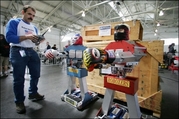
by Glenn Chapman Tue Jun 19, 8:26 AM ET
SAN FRANCISCO (AFP) - The floor shudders as a hulking robot called The Judge pounds a pneumatic hammer into the heavily-armored top of Little Blue Engine at the RoboGames in San Francisco.
The pounded robot races forward, driving a wedge-shaped nose under The Judge and flipping the 340-pound (154 kilogram) machine into bulletproof Plexiglas that walls the battle zone off from enthralled spectators.
After three minutes of thunderous slamming, ramming and whacking underdog Little Blue is declared the winner over a combat robot competitors here spoke of with awe prior to the match.
As is the case in matches ending with both combatants still functioning, the victor is the one showing the least damage and the most aggression.
"It's an adrenaline rush," Blue Engine's controller Joshua O'Briant of southern California said, as his team hauled the robot from the arena to prepare it for the next elimination round.
"I'm still feeling it. We are the Little Blue Engine that could, and we did."
Rows of wooden folding tables strewn with gears, wheels, circuit boards, tools, metal parts and nibbled snacks fill much of the pavilion where machines faced off this weekend in RoboGames.
The air is heavy with the odor of fresh welds.
"Battle bots" modeled after tanks and driven by sturdy wheels are armed with flippers, spinners, hammers, saws, flame throwers or combinations of such weaponry.
"Drivers" stand outside the Plexiglas, wirelessly commanding robots with custom-made toggle-boxes or modified video game console controllers such as those from Sony's PlayStation and Nintendo's Wii.
"What a buzz," John Frizell of Britain told AFP after his "Terror Turtle" robot made from salvaged material was defeated in the arena.
"After working the controls for a while it feels as though you're actually in the ring, except without the risk of getting destroyed."
Nearby, Mark Demers of Canada and his team fit a titanium cover onto their monster robot with a metal tongue that works as a "flipper" powered by compressed nitrogen gas.
"It sends robots flying," Demers said with a confident smile, eager to take on legendary heavyweight "Vladiator," which is back in the ring after a hiatus from competing.
O'Briant says that while robot combat is an entertaining outlet for engineers, innovations born of battles spill into products that promise to change the ways people live.
O'Briant is part of an Axion Racing Team that builds driverless cars, having maneuvered one 140 miles (225 kilometers).
"We love being here," O'Briant said as some of Little Blue's armor was stripped off and a powerful flipper attached. "We sharpen our skills and use them for good instead of evil."
The sounds of crashing machines and cheering fans echo about the cavernous pavilion built on a pier on San Francisco Bay near Alcatraz Island and the Golden Gate Bridge.
Yu-ting Yang and fellow students from Tamkang University in Taipei ignore the noise as their small humanoid robots independently lift weights and kick balls into goals on a miniature soccer field.
Robots from around the world are competing for supremacy in soccer, basketball, sumo wrestling and other events at the machine version of the Olympics.
"This is not just playing," Yang told AFP. "Our robots have to see, balance and be able to find things all by themselves. It is difficult."
Matt Bauer of Ohio focuses on a laptop computer screen filled with program code that his humanoid robot translates into commands such as stand, kick, punch or squat.
"Ultimately, we are trying to replicate the human race and motion," Bauer told AFP. "Translate math and computer code into the human race. It's not easy to do but as time goes on you get better at it."
Humanoid robots about 250 millimeters (10 inches) tall compete in wrestling, martial arts, and "anything goes" matches in which the goal is to have the most agile, versatile performer.
"Over there you have a lot more testosterone and here you have more technology," Rob Farrell said, nodding toward the combat arena as he and his son, Chris, fine-tuned androids Oro and Zog.
Oro is named for a Tahitian god of war. Zog is named after a villain from a Flash Gordon science fiction film series dating back to the 1930s.
"Robots are the future," said Chris Farrell, who will study robotics when he heads to college later this year. "They will be everywhere."
( What's this? )
Copyright © 2007 Agence France Presse.
All rights reserved. The information contained in the AFP News report
may not be published, broadcast, rewritten or redistributed without the
prior written authority of Agence France Presse.
| Copyright © 2007 Yahoo! Inc. All rights reserved. Questions or Comments Privacy Policy -Terms of Service - Copyright/IP Policy - Ad Feedback |